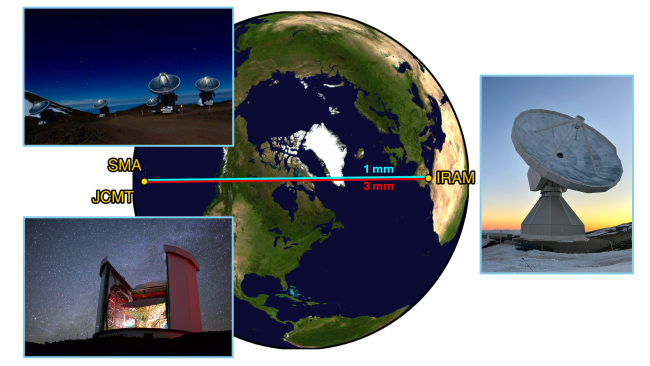Astronomers take the first step towards multi-color black hole observations with the Event Horizon Telescope
A recent technical demonstration paves the way for next-generation black hole imaging.
Cambridge, MA - An international team of astronomers has successfully demonstrated a new technique to observe especially faint black holes by correcting for atmospheric effects on Earth. The technique, called “frequency phase transfer (FPT),” can now be implemented at observatories participating in the Event Horizon Telescope (EHT), making the global array more sensitive than ever before.
By linking together three EHT telescopes – the IRAM 30-meter telescope atop Pico Veleta, Spain and the James Clerk Maxwell Telescope and Submillimeter Array on Maunakea, Hawai’i – the astronomers showed that measurements of the atmosphere at a wavelength of 3mm could be used to enhance data taken at a wavelength of 1mm. The results, led by Sara Issaoun and Dom Pesce of the Smithsonian Astrophysical Observatory, were published in the Astronomical Journal last month.

The recent FPT demonstration involved observations with the IRAM 30-meter telescope in Spain (right), the Submillimeter Array (SMA) in Hawaii (upper left), and the James Clerk Maxwell Telescope (JCMT) in Hawaii (lower left).
The EHT is a globe-spanning array of radio telescopes that uses a technique called very long baseline interferometry (VLBI) to produce the sharpest images in all of astronomy. This technique – which digitally combines the signals from radio-telescopes around the globe to form a single “virtual” Earth-sized telescope – famously enabled the EHT Collaboration to take the first pictures of a black hole.
In addition to the technical challenges of operating an Earth-sized telescope, the EHT must peer through Earth’s turbulent atmosphere. This turbulence scrambles the radio signals that the EHT collects, limiting the maximum “exposure time” for an image and restricting EHT observations to only the very brightest objects in the sky.
The FPT technique has previously been proposed as a solution to these atmospheric limitations. It was developed for VLBI and demonstrated at longer wavelengths by the Korean VLBI Network, which has also been a key participant in the current experiment. In essence, FPT uses observations taken at one wavelength of light to measure the amount of scrambling that the atmosphere is imparting onto the data, then uses that information to unscramble data taken at another wavelength of light. With the ability to unscramble data, the EHT could take longer exposures and thereby see fainter objects, opening up a treasure trove of black hole science. Previous research has demonstrated that the FPT technique works well for long wavelengths of light, but it had never been tested for the short wavelengths at which the EHT observes.
While the FPT technique provides a promising avenue for improving the sensitivity of the EHT, it does pose its own implementation difficulty: for a telescope to utilize FPT, it must be able to
observe at least two wavelengths of light simultaneously. Such “multi-color” capabilities are not common among the radio telescopes that participate in the EHT, most of which can only observe a single wavelength of light at a time. However, this recent FPT success motivates the build-out of additional multi-color capabilities across the EHT array, as a key feature of the future roadmap for the EHT Collaboration and of ongoing programs like the next-generation EHT (ngEHT) and the Black Hole Explorer (BHEX).